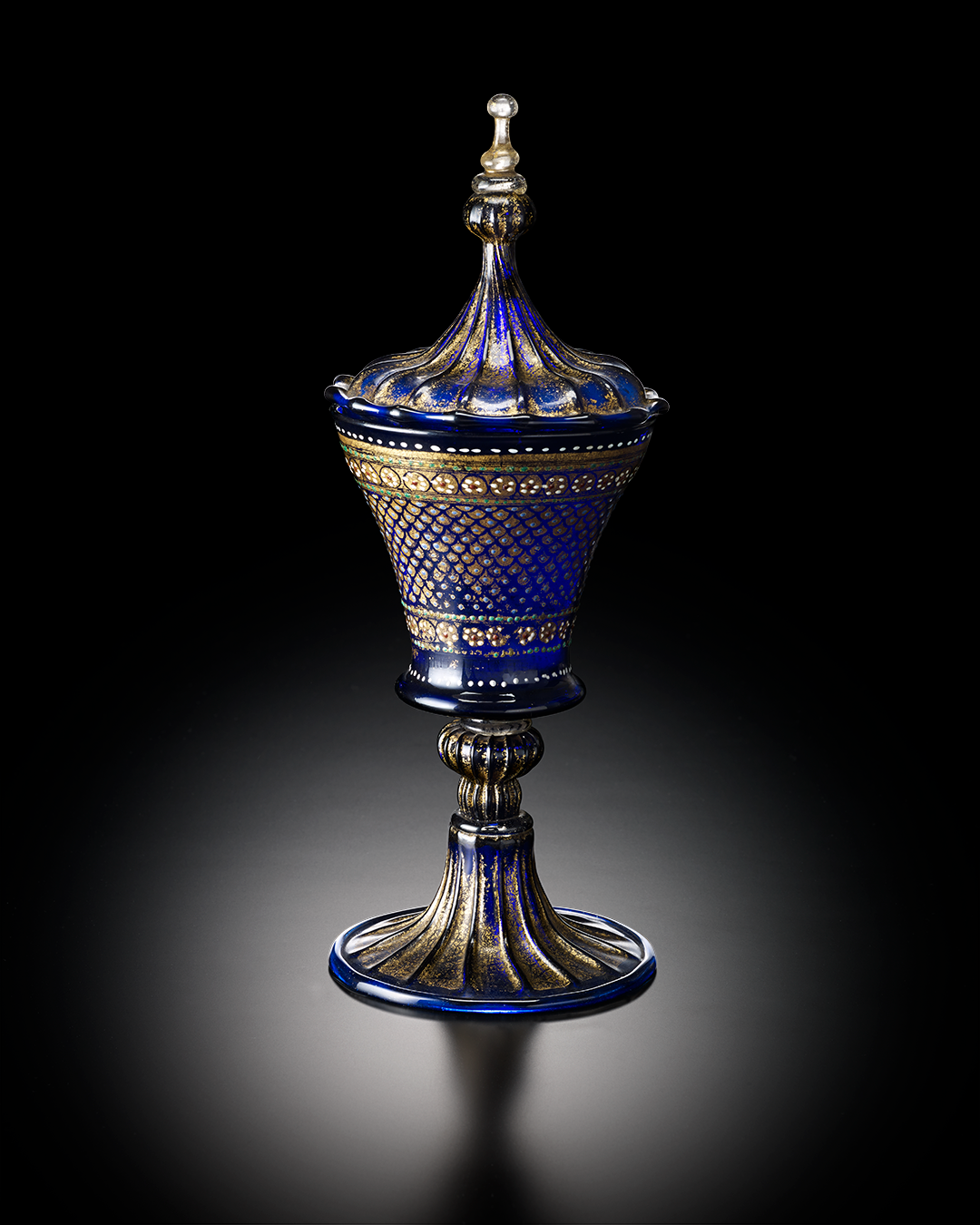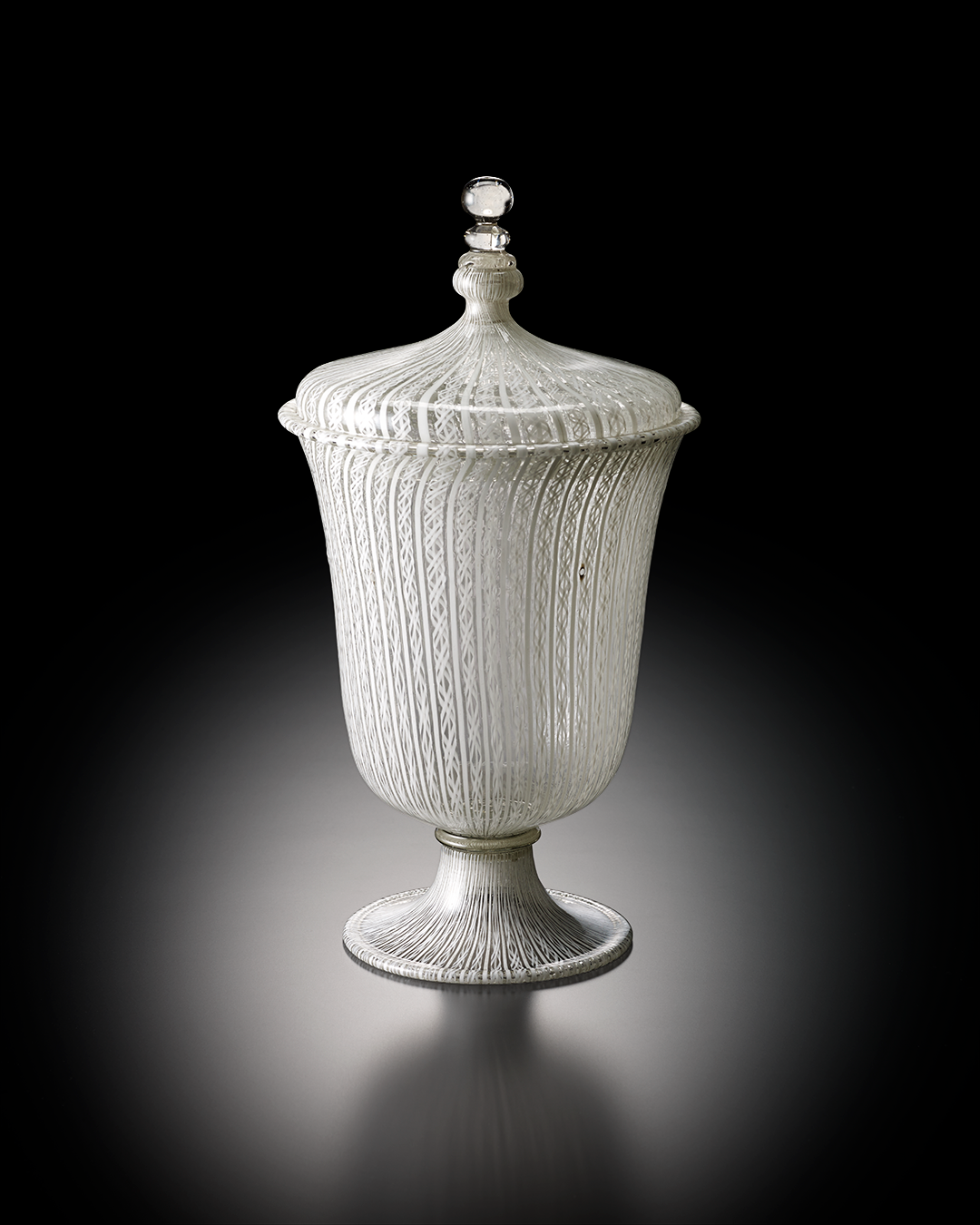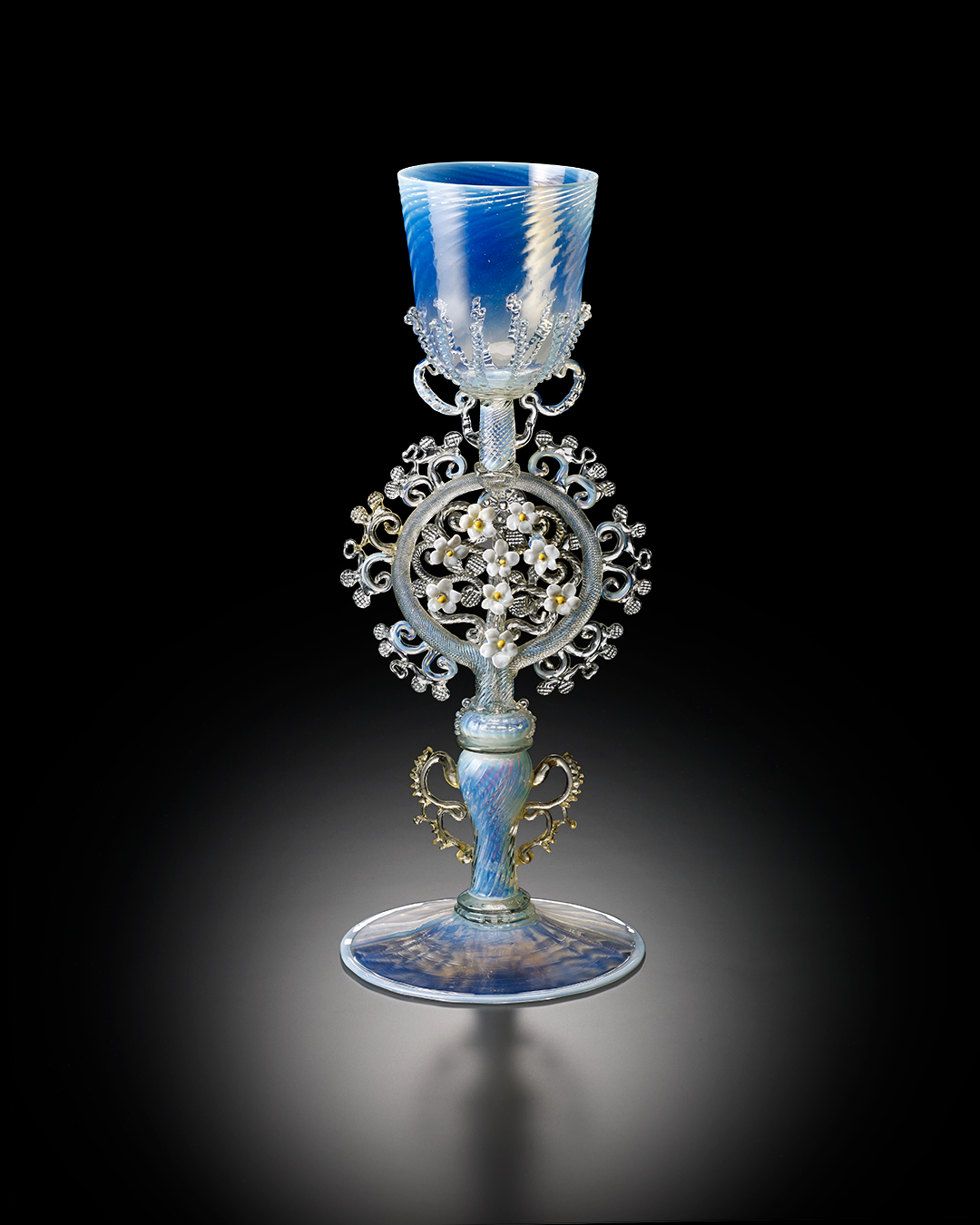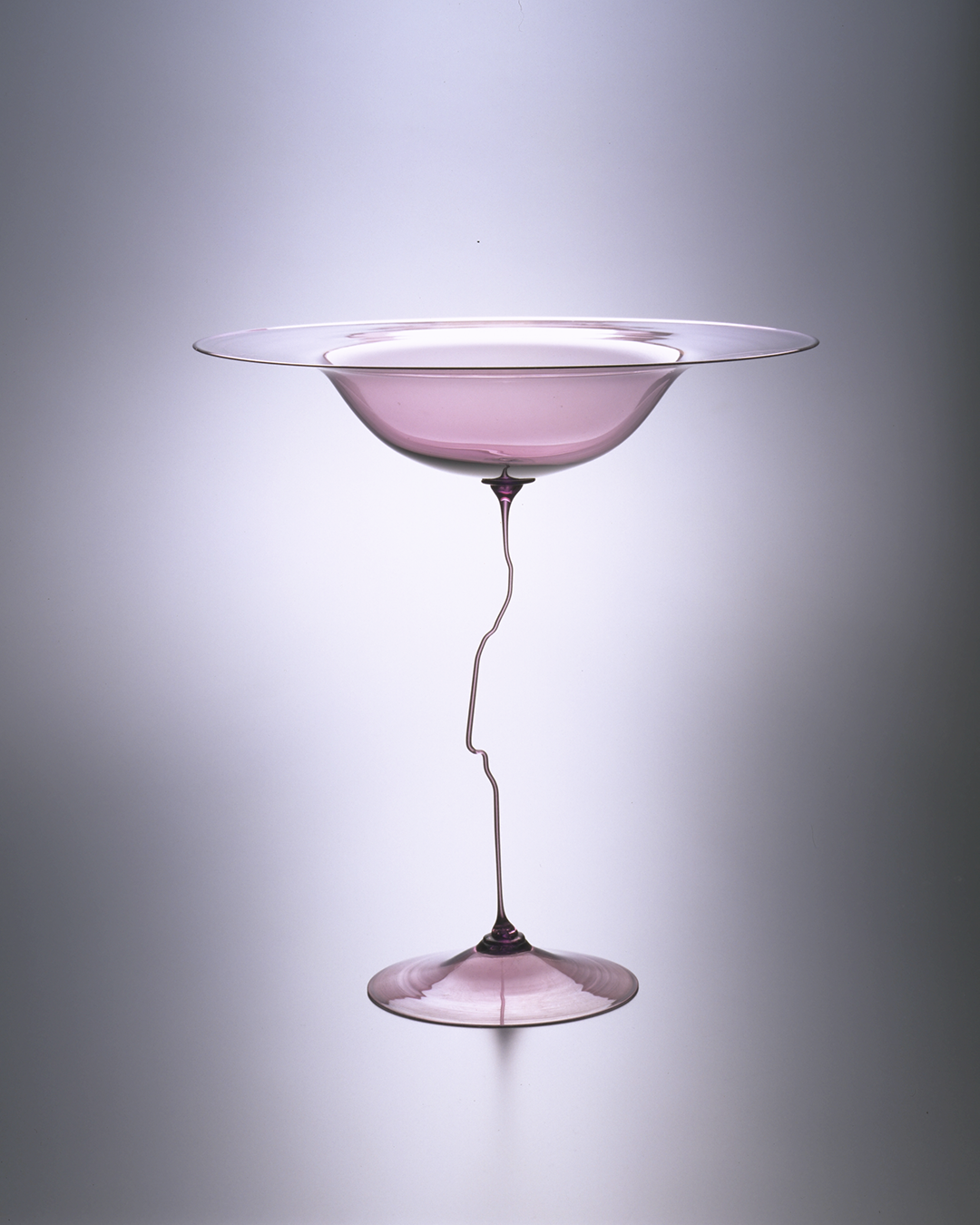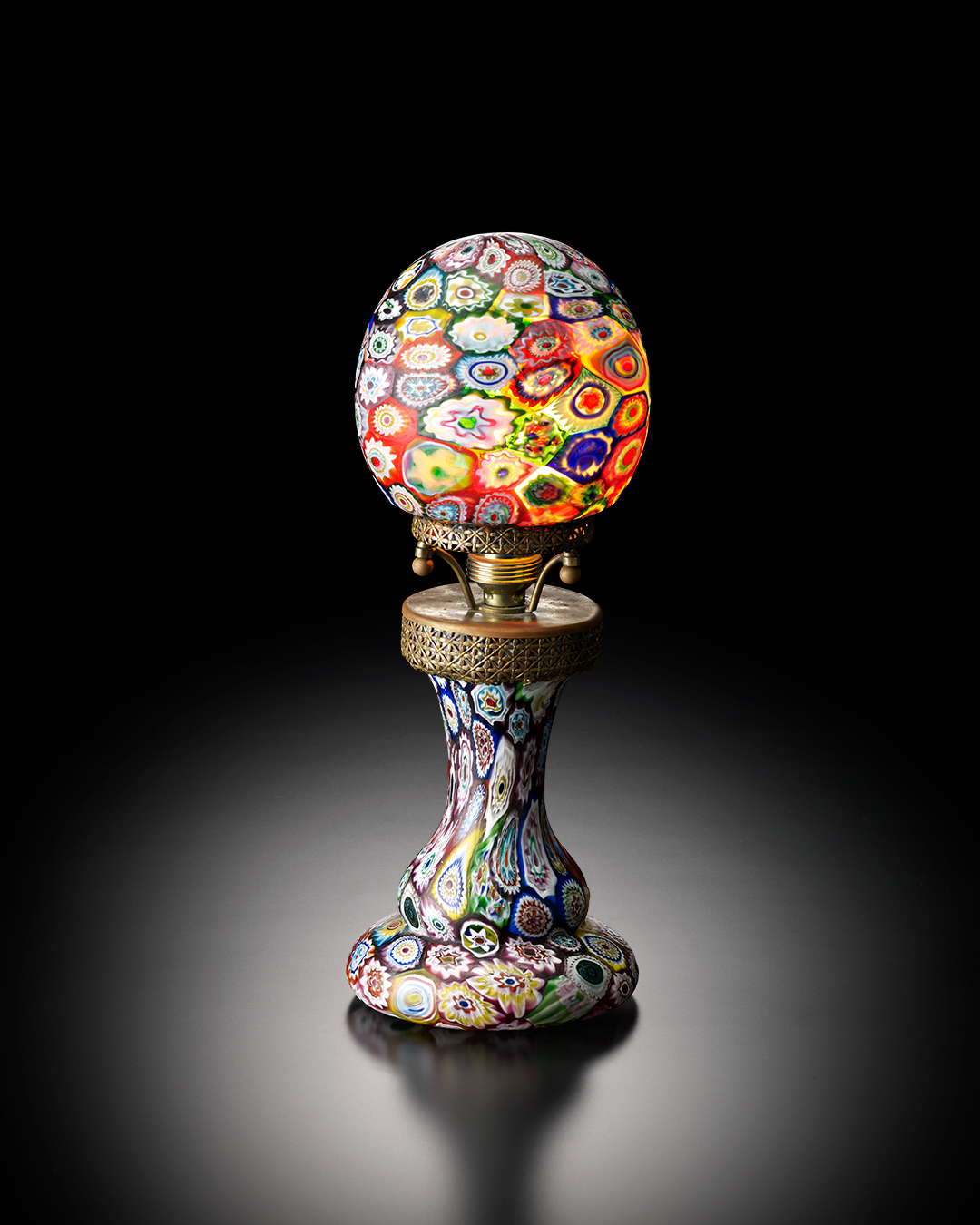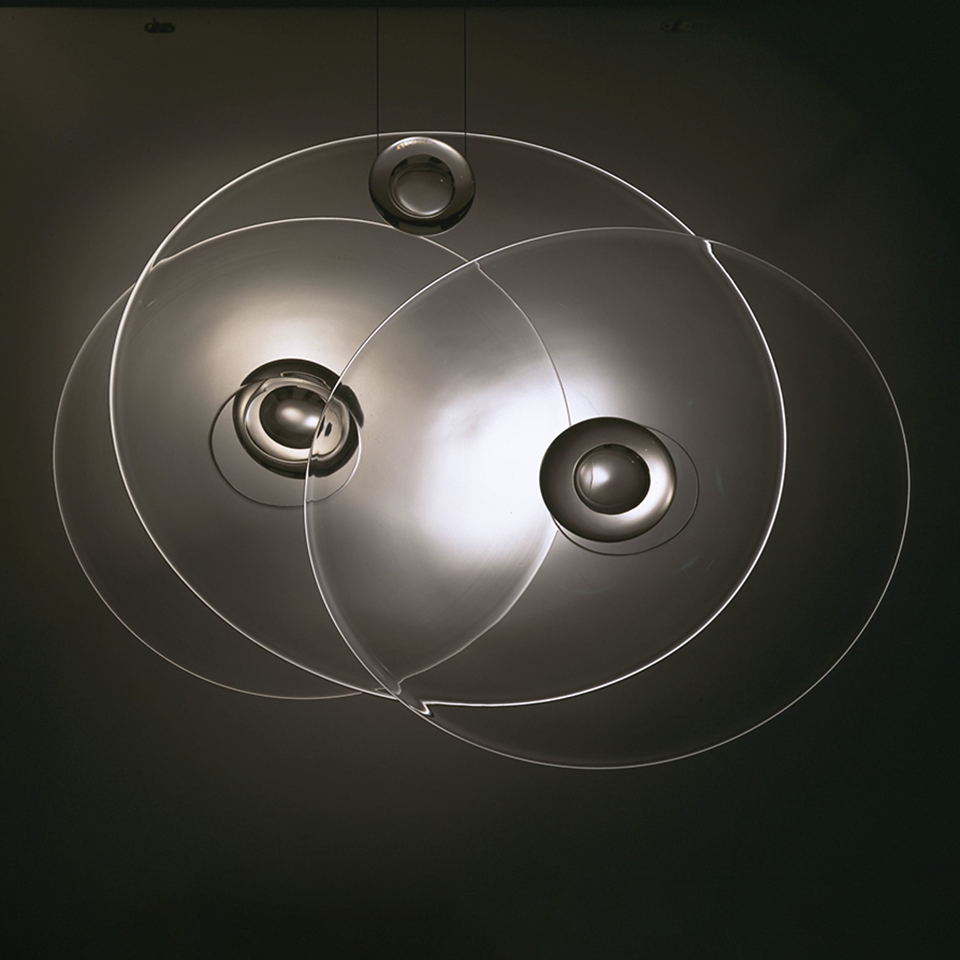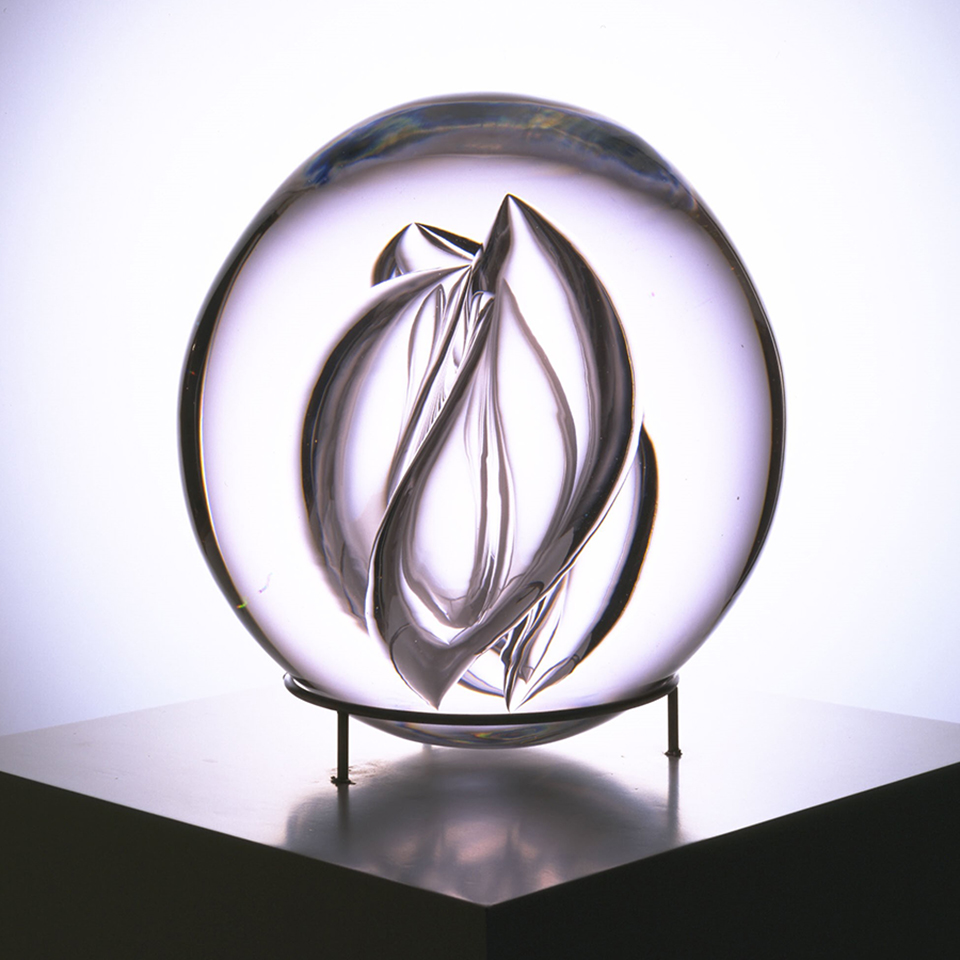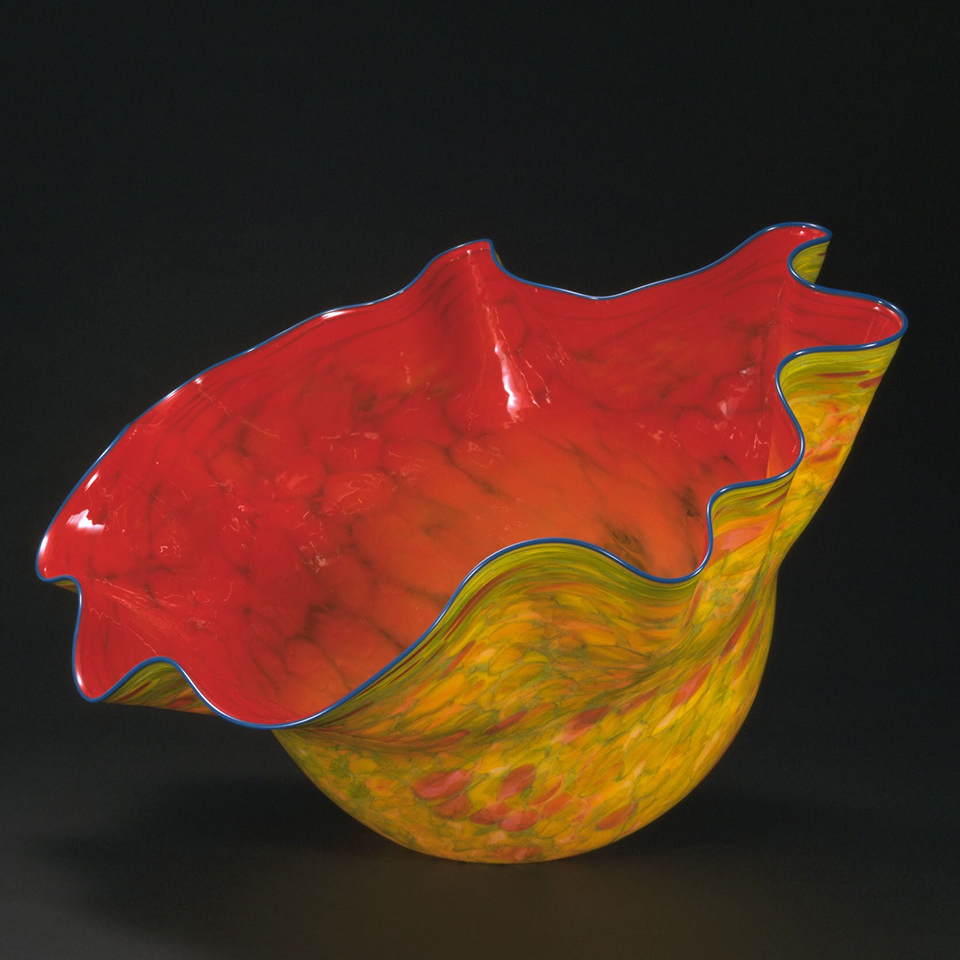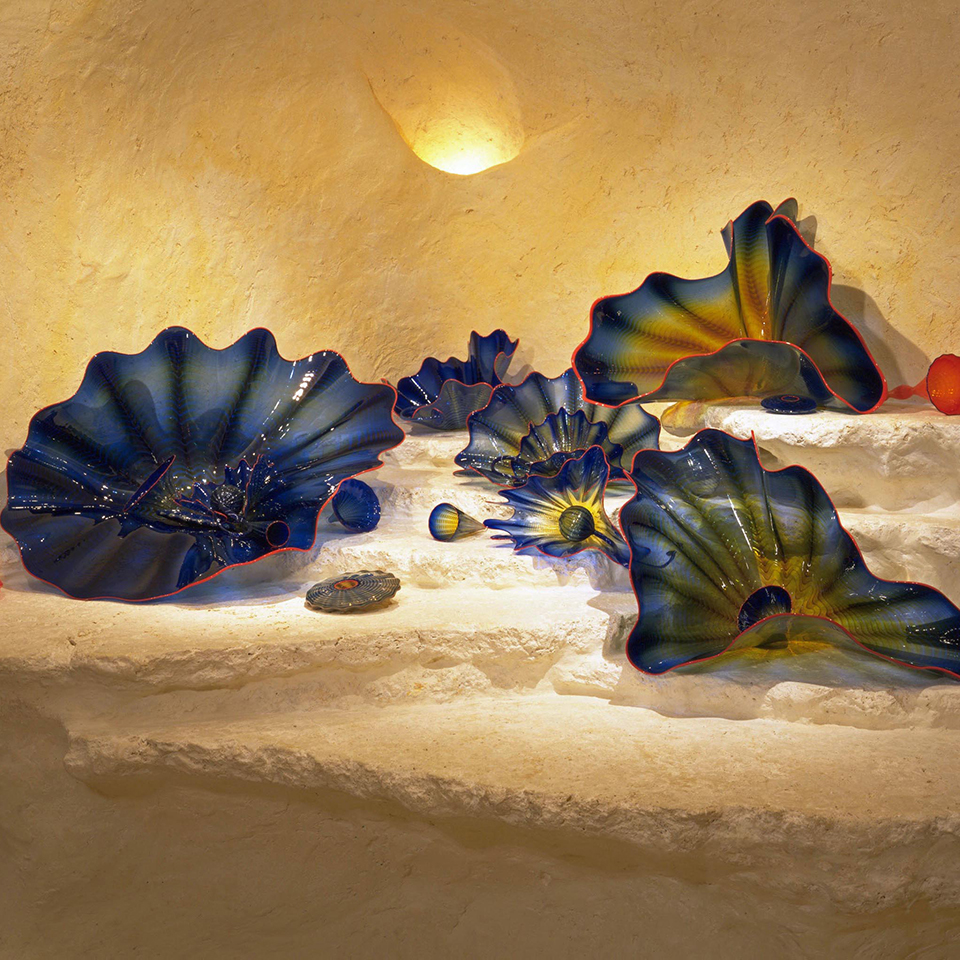뛰어난 기술로 빚어낸 아름다움의 극치
섬세하고 우아한 광채를 마음껏 즐겨보세요.
황금기인 15~16세기에 제작된 베네치아 유리를 중심으로 기원전의 고대 유리, 19세기 살비아티 공방 등에 의해 부활한 장식 유리 및 20세기에 등장한 유리 예술 등 약 1,000여 점의 소장품 중 기획에 맞춰 엄선한 약 100점을 상시 전시하고 있습니다.
뛰어난 기술로 빚어낸 아름다움의 극치
섬세하고 우아한 광채를 마음껏 즐겨보세요.
황금기인 15~16세기에 제작된 베네치아 유리를 중심으로 기원전의 고대 유리, 19세기 살비아티 공방 등에 의해 부활한 장식 유리 및 20세기에 등장한 유리 예술 등 약 1,000여 점의 소장품 중 기획에 맞춰 엄선한 약 100점을 상시 전시하고 있습니다.
뛰어난 기술로 빚어낸 아름다움의 극치
섬세하고 우아한 광채를 마음껏 즐겨보세요.
황금기인 15~16세기에 제작된 베네치아 유리를 중심으로 기원전의 고대 유리, 19세기 살비아티 공방 등에 의해 부활한 장식 유리 및 20세기에 등장한 유리 예술 등 약 1,000여 점의 소장품 중 기획에 맞춰 엄선한 약 100점을 상시 전시하고 있습니다.
뛰어난 기술로 빚어낸 아름다움의 극치
섬세하고 우아한 광채를 마음껏 즐겨보세요.
황금기인 15~16세기에 제작된 베네치아 유리를 중심으로 기원전의 고대 유리, 19세기 살비아티 공방 등에 의해 부활한 장식 유리 및 20세기에 등장한 유리 예술 등 약 1,000여 점의 소장품 중 기획에 맞춰 엄선한 약 100점을 상시 전시하고 있습니다.
History of Venetian glass
Since the time of ancient Rome to today, Venetian glass has been a major part of Venetian history and has set the destiny of people on Murano.
The Roman Empire
The history of Venetian glass started with Roman glass in the Roman Empire (1st century BC to 5th century AD). Glassblowing was a revolutionary invention already used by many glass factories throughout the Italian peninsula. Glassmaking techniques and glassware spread throughout the world. However, with the fall of the Roman Empire in 476, the glass industry quickly declined.
Rialto
In the 8th century, the central part of the Venetian Republic moved to Rialto, where many churches and cathedrals were built all over the island. Many glass factories also moved to Rialto.
Booming glass industry
In 1078, the reconstruction of St. Mark’s Basilica started. Glass mosaics were installed on all the walls. According to historical documents, 29 glassworkers were fined for violating glassmaking customs and regulations. This indicates a booming glass industry.
Governmental protection and control
The 13th century saw major involvement of the government in the Venetian glass industry. It formed the Venetian Glass Guild in 1268, concluded contracts with Antioch (Syria’s largest producer of glass) to import raw glass materials, directly controlled firewood to streamline fuel management, and banned operations in summer.
Then in 1291, the Venetian government, seeking to protect the Venetian glass industry, enacted a law to require all glass makers, assistants, and their families to move to Murano island. Any escapees would be punished with death. The development of Venetian glass then centered on Murano.
The heyday of Venetian glass
In the 13th and 14th centuries, Venetian glass developed under the strong influence of Byzantine and Islamic aesthetics, especially in enameling techniques and designs. In the 15th century, it matured further with the backdrop of the Italian Renaissance.
In the latter half of the 16th century, Venetian glass reached its zenith with many groundbreaking techniques for finer and more splendid designs like diamond-point engraving, lace glass (filigrana), crystal glass, crackled glass, and marbled glass. Glassware in diverse forms for diverse functions were produced.
Hard times
In the 18th century, a new industrialism emerged in Europe when countries imposed high tariffs on imported goods to protect domestic industries. As a result, glass-producing countries suffered a drastic drop in exports and many glass factories went bankrupt. Murano was no exception.
To overcome these hard times, Murano glassmakers did whatever they could to survive by producing finer mosaics, church interiors and ornaments, and exporting to Africa and Southeast Asia. However, the dissolution of the Venetian Republic in 1797 marked the end of governmental patronage of the glass industry. Ten years later in 1806, Murano’s venerable glassmakers’ guild was forced to disband after 500 years.
The modernization of Venetian glass
While Murano’s glass industry faced stagnation, modernization kicked off a new era in the 19th century. Many museums and archives were established as new platforms for industry and education. The new museums needed vintage artifacts to be exhibited. But there were not enough of them, so Murano’s master glassmakers created replicas of ancient glassware.
This was followed by their glass mosaic techniques with colored glass inimitable by any glassmaker in any other country. They restored old church murals and created a new sector for interior design glasswork. It was a new beginning after a period of hardship.
Murano also saw many new movements. They included the construction of modern factories, the loosening of the closed system, the establishment of educational institutions for apprentices, the construction of glass museums, and the organizing of exhibitions and research societies. Through the cooperation of pioneering leaders and traditional craftsmen, Venetian glass arose from a dark period to go forward on the path to modernization.
History of Venetian glass
Since the time of ancient Rome to today, Venetian glass has been a major part of Venetian history and has set the destiny of people on Murano.
The Roman Empire
The history of Venetian glass started with Roman glass in the Roman Empire (1st century BC to 5th century AD). Glassblowing was a revolutionary invention already used by many glass factories throughout the Italian peninsula. Glassmaking techniques and glassware spread throughout the world. However, with the fall of the Roman Empire in 476, the glass industry quickly declined.
Rialto
In the 8th century, the central part of the Venetian Republic moved to Rialto, where many churches and cathedrals were built all over the island. Many glass factories also moved to Rialto.
Booming glass industry
In 1078, the reconstruction of St. Mark’s Basilica started. Glass mosaics were installed on all the walls. According to historical documents, 29 glassworkers were fined for violating glassmaking customs and regulations. This indicates a booming glass industry.
Governmental protection and control
The 13th century saw major involvement of the government in the Venetian glass industry. It formed the Venetian Glass Guild in 1268, concluded contracts with Antioch (Syria’s largest producer of glass) to import raw glass materials, directly controlled firewood to streamline fuel management, and banned operations in summer.
Then in 1291, the Venetian government, seeking to protect the Venetian glass industry, enacted a law to require all glass makers, assistants, and their families to move to Murano island. Any escapees would be punished with death. The development of Venetian glass then centered on Murano.
The heyday of Venetian glass
In the 13th and 14th centuries, Venetian glass developed under the strong influence of Byzantine and Islamic aesthetics, especially in enameling techniques and designs. In the 15th century, it matured further with the backdrop of the Italian Renaissance.
In the latter half of the 16th century, Venetian glass reached its zenith with many groundbreaking techniques for finer and more splendid designs like diamond-point engraving, lace glass (filigrana), crystal glass, crackled glass, and marbled glass. Glassware in diverse forms for diverse functions were produced.
Hard times
In the 18th century, a new industrialism emerged in Europe when countries imposed high tariffs on imported goods to protect domestic industries. As a result, glass-producing countries suffered a drastic drop in exports and many glass factories went bankrupt. Murano was no exception.
To overcome these hard times, Murano glassmakers did whatever they could to survive by producing finer mosaics, church interiors and ornaments, and exporting to Africa and Southeast Asia. However, the dissolution of the Venetian Republic in 1797 marked the end of governmental patronage of the glass industry. Ten years later in 1806, Murano’s venerable glassmakers’ guild was forced to disband after 500 years.
The modernization of Venetian glass
While Murano’s glass industry faced stagnation, modernization kicked off a new era in the 19th century. Many museums and archives were established as new platforms for industry and education. The new museums needed vintage artifacts to be exhibited. But there were not enough of them, so Murano’s master glassmakers created replicas of ancient glassware.
This was followed by their glass mosaic techniques with colored glass inimitable by any glassmaker in any other country. They restored old church murals and created a new sector for interior design glasswork. It was a new beginning after a period of hardship.
Murano also saw many new movements. They included the construction of modern factories, the loosening of the closed system, the establishment of educational institutions for apprentices, the construction of glass museums, and the organizing of exhibitions and research societies. Through the cooperation of pioneering leaders and traditional craftsmen, Venetian glass arose from a dark period to go forward on the path to modernization.
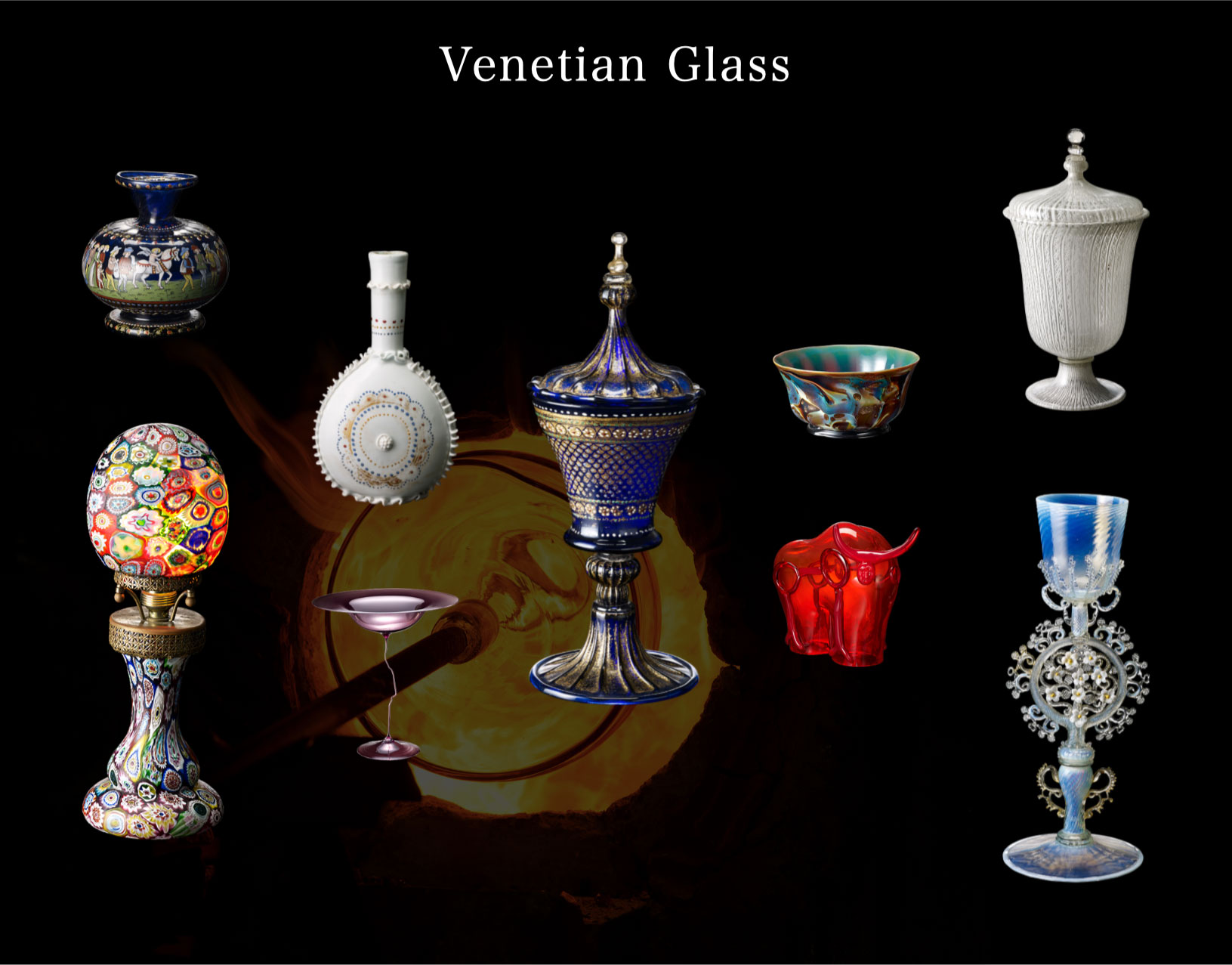



기법
모자이크 유리(밀레피오리 유리)
기원전 15세기경 메소포타미아 지방에서 이미 제작되어 기원전 2세기부터 기원후 1세기경 고대 로마제국에서 발전했다. 이후 잠시 쇠퇴했지만 19세기 베네치아의 유리 장인에 의해 복원된 기법이다. 모자이크 유리의 재료가 되는 다양한 무늬의 유리 조각은 여러 겹의 유리를 입힌 유리 비즈를 가늘게 펴서 유리 막대로 만든 후, 수평으로 잘라서 만든다. 마치 유리 그릇에 꽃이 핀 것처럼 보인다고 해서 이탈리아어로 ‘천 송이 꽃’이라는 뜻의 ‘밀레피오리’라고도 부른다.
레이스 유리
투명한 유리와 유백색 등의 유색 유리를 조합하여 가는 선으로 레이스 뜨개질과 같은 무늬를 만들어낸 유리 그릇의 총칭이다. 기원전 3세기 이후 이탈리아나 알렉산드리아의 유리 제품에도 비슷한 기법으로 만들어진 사례가 존재하지만, 이를 발전시키고 세련되게 가공한 것은 16세기 중반 베네치아의 유리 장인들이다. 섬세하고 정교한 레이스 유리는 이후 베네치아 유리의 대명사가 되었다. 이탈리아에서는 레이스 유리를 ‘필리그라나’라고 부르며, 유백색 유리를 구성하는 무늬의 차이에 따라 나선형 무늬의 ‘아 레토르티’, 격자 무늬의 ‘아 레티첼로’, 평행선 모양 줄무늬의 ‘아 필리’ 등 크게 세 가지 종류로 나뉜다.
마블 유리
서로 다른 색의 유리를 녹여 반죽한 소재로 성형하고, 표면에 대리석, 옥수, 마노 등 천연 보석의 무늬를 표현한 유리이다. 마블 유리 중에서도 15세기 후반 베네치아에서 고안되어 16~17세기에 유행한, 소재에 은이온을 함유한 유리는 빛이 투과하면 유리의 색이 붉은색으로 변하기 때문에 ‘칼체도니오'(이탈리아어로 홍옥수)라고 불린다. 17세기 후반부터 18세기까지는 금속이나 금속 화합물을 유리 안에 결정으로 만든 아벤츄린 유리를 뿌린 작품도 제작되었다.
기법
모자이크 유리(밀레피오리 유리)
기원전 15세기경 메소포타미아 지방에서 이미 제작되어 기원전 2세기부터 기원후 1세기경 고대 로마제국에서 발전했다. 이후 잠시 쇠퇴했지만 19세기 베네치아의 유리 장인에 의해 복원된 기법이다. 모자이크 유리의 재료가 되는 다양한 무늬의 유리 조각은 여러 겹의 유리를 입힌 유리 비즈를 가늘게 펴서 유리 막대로 만든 후, 수평으로 잘라서 만든다. 마치 유리 그릇에 꽃이 핀 것처럼 보인다고 해서 이탈리아어로 ‘천 송이 꽃’이라는 뜻의 ‘밀레피오리’라고도 부른다.
레이스 유리
투명한 유리와 유백색 등의 유색 유리를 조합하여 가는 선으로 레이스 뜨개질과 같은 무늬를 만들어낸 유리 그릇의 총칭이다. 기원전 3세기 이후 이탈리아나 알렉산드리아의 유리 제품에도 비슷한 기법으로 만들어진 사례가 존재하지만, 이를 발전시키고 세련되게 가공한 것은 16세기 중반 베네치아의 유리 장인들이다. 섬세하고 정교한 레이스 유리는 이후 베네치아 유리의 대명사가 되었다. 이탈리아에서는 레이스 유리를 ‘필리그라나’라고 부르며, 유백색 유리를 구성하는 무늬의 차이에 따라 나선형 무늬의 ‘아 레토르티’, 격자 무늬의 ‘아 레티첼로’, 평행선 모양 줄무늬의 ‘아 필리’ 등 크게 세 가지 종류로 나뉜다.
마블 유리
서로 다른 색의 유리를 녹여 반죽한 소재로 성형하고, 표면에 대리석, 옥수, 마노 등 천연 보석의 무늬를 표현한 유리이다. 마블 유리 중에서도 15세기 후반 베네치아에서 고안되어 16~17세기에 유행한, 소재에 은이온을 함유한 유리는 빛이 투과하면 유리의 색이 붉은색으로 변하기 때문에 ‘칼체도니오'(이탈리아어로 홍옥수)라고 불린다. 17세기 후반부터 18세기까지는 금속이나 금속 화합물을 유리 안에 결정으로 만든 아벤츄린 유리를 뿌린 작품도 제작되었다.
베네치아 유리 미술관 대표 작품
베네치아 유리 미술관 대표 작품
현대 유리 미술관
20세기에 들어서면서 새로운 생명을 불어넣은 참신한 현대 유리 예술 작품.
베네치아의 유리 조각가 리비오 세구소와 미국의 유리 예술가 데일 치훌리의 작품을 전시하고 있습니다.
유리의 무한한 가능성을 관람하세요.
현대 유리 미술관
20세기에 들어서면서 새로운 생명을 불어넣은 참신한 현대 유리 예술 작품.
베네치아의 유리 조각가 리비오 세구소와 미국의 유리 예술가 데일 치훌리의 작품을 전시하고 있습니다.
유리의 무한한 가능성을 관람하세요.
작가 소개
리비오 세구소
1930~
베네치아 출생. 소년 시절부터 유리라는 소재의 매력에 매료되어 삼촌이자 세계적인 유리 장인인 알프레도 바르비니에게 베네치아 유리의 전통 기술을 배웠다.
20세에 유리 공예의 마에스트로가 된 세구소는 유리 조각 작품을 연구하여 무색투명한 유리의 아름다움을 극대화한 조형과 공간, 그리고 빛이 조화를 이루는 작품을 제작하고 있다. 1970년대 말부터 세련한 원형과 타원형을 활용한 독창적인 스타일을 확립했다. 1980년대에는 한 번 제작한 원형 유리를 여러 조각으로 절단하여 원래 형태와 다른 형태로 재구성하는 새로운 시도를 하기도 했다.
현재도 유리를 금속, 대리석, 나무 등 이질적인 재료와 결합하여 투명한 유리의 아름다움과 조화를 이루는, 그의 시적인 내면성을 느낄 수 있는 작품을 제작하고 있다.
데일 치훌리
1941~
워싱턴 대학에서 인테리어 디자인을 공부하던 중 유리를 만났다. 그 가능성에 매료되어 1965년 위스콘신 대학에 진학하여 스튜디오 글라스 운동의 창시자 하비 K. 리틀턴에게 사사했다. 1968년에는 베네치아 무라노 섬으로 유학을 떠나 베니니 공방에서 베네치아 유리의 전통과 팀을 이루어 작품을 제작하는 스타일에 강한 영향을 받았다. 이후 무라노 섬 유학 경험 등을 바탕으로 1971년 워싱턴 주에 유리 교육 시설인 필척 유리학교를 공동 설립했다. 전 세계 유리 작가들의 연구와 정보 교류의 장으로 지금도 유리계의 발전에 기여하고 있다.
탁월한 발상력과 색채, 조형 감각을 살린 ‘마키아'(1981년~), ‘페르시안'(1986년~), ‘베네치아'(1988년~) 등 생동감과 생명력 넘치는 시리즈 작품을 발표. ‘미국 인간 국보상'(1992년)을 비롯한 다수의 상을 수상했고, 1996년 베니스에서 열린 ‘현대 유리조형작가 국제전시회’에 초대 작가로 출품, 2012년에는 시애틀 센터에 정원과 작품이 어우러진 ‘치훌리 가든&글라스’를 오픈하는 등 왕성한 활동을 하고 있다.
현대 유리 미술관
20세기에 들어서면서 새로운 생명을 불어넣은 참신한 현대 유리 예술 작품.
베네치아의 유리 조각가 리비오 세구소와 미국의 유리 예술가 데일 치훌리의 작품을 전시하고 있습니다.
유리의 무한한 가능성을 관람하세요.
현대 유리 미술관
20세기에 들어서면서 새로운 생명을 불어넣은 참신한 현대 유리 예술 작품.
베네치아의 유리 조각가 리비오 세구소와 미국의 유리 예술가 데일 치훌리의 작품을 전시하고 있습니다.
유리의 무한한 가능성을 관람하세요.
작가 소개
리비오 세구소
1930~
베네치아 출생. 소년 시절부터 유리라는 소재의 매력에 매료되어 삼촌이자 세계적인 유리 장인인 알프레도 바르비니에게 베네치아 유리의 전통 기술을 배웠다.
20세에 유리 공예의 마에스트로가 된 세구소는 유리 조각 작품을 연구하여 무색투명한 유리의 아름다움을 극대화한 조형과 공간, 그리고 빛이 조화를 이루는 작품을 제작하고 있다. 1970년대 말부터 세련한 원형과 타원형을 활용한 독창적인 스타일을 확립했다. 1980년대에는 한 번 제작한 원형 유리를 여러 조각으로 절단하여 원래 형태와 다른 형태로 재구성하는 새로운 시도를 하기도 했다.
현재도 유리를 금속, 대리석, 나무 등 이질적인 재료와 결합하여 투명한 유리의 아름다움과 조화를 이루는, 그의 시적인 내면성을 느낄 수 있는 작품을 제작하고 있다.
데일 치훌리
1941~
워싱턴 대학에서 인테리어 디자인을 공부하던 중 유리를 만났다. 그 가능성에 매료되어 1965년 위스콘신 대학에 진학하여 스튜디오 글라스 운동의 창시자 하비 K. 리틀턴에게 사사했다. 1968년에는 베네치아 무라노 섬으로 유학을 떠나 베니니 공방에서 베네치아 유리의 전통과 팀을 이루어 작품을 제작하는 스타일에 강한 영향을 받았다. 이후 무라노 섬 유학 경험 등을 바탕으로 1971년 워싱턴 주에 유리 교육 시설인 필척 유리학교를 공동 설립했다. 전 세계 유리 작가들의 연구와 정보 교류의 장으로 지금도 유리계의 발전에 기여하고 있다.
탁월한 발상력과 색채, 조형 감각을 살린 ‘마키아'(1981년~), ‘페르시안'(1986년~), ‘베네치아'(1988년~) 등 생동감과 생명력 넘치는 시리즈 작품을 발표. ‘미국 인간 국보상'(1992년)을 비롯한 다수의 상을 수상했고, 1996년 베니스에서 열린 ‘현대 유리조형작가 국제전시회’에 초대 작가로 출품, 2012년에는 시애틀 센터에 정원과 작품이 어우러진 ‘치훌리 가든&글라스’를 오픈하는 등 왕성한 활동을 하고 있다.
